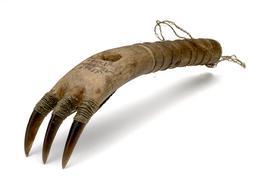The story goes that a child with a very large mouth decided to eat his mother and then proceeded to go from one house to another eating more people in the village. Ap’apaa, as the hungry creature was known, was also the subject of a game village children would play by re-enacting Ap’apaa’s appetite.
A sikunun kumiġaun, or ice scratcher, consisted of seal claws attached to pieces of wood. Hunters would use the ice scratcher to mimic the sounds that seals make when digging breathing holes through the ice. A hunter would cover himself with white animal skin or a parka when stalking a seal. If the seal sensed danger, the hunter would scrape the ice with the scratcher, the sound of which would comfort the seal or perhaps lull it to sleep.
These artifacts are part of an online collection found on the Arctic Studies Center web site, a part of the Smithsonian Institution focusing on the history, culture and people of the region. The site has interactive maps that provide information about the indigenous groups of people living in Alaska and Siberia. For example, the Chukchi people border these worlds, living between “the culture of reindeer herding (chavchyvat) and the culture of sea mammal hunting (angkal’yt).”
Within the Sharing Knowledge section of the site, you can also find the artifact collection where the Yup’ik mask and ice scratcher are listed among other artifacts across 10 native communities. These artifacts are accompanied with additional information provided by community elders and further historical background information.
The site also has sections dedicated to Viking history as well as the Ainu, the indigenous people of Northern Japan in Hokkaido. Teachers can order support materials for teaching by contacting the Smithsonian.
The online artifacts collection and support materials can be used in conjunction with the archaeology lessons and activities highlighted in our Across the Curriculum department. See What’s the Difference? Activities to Teach Paleontology and Archaeology for more information.
This article was written by Robert Payo. For more information, see the Contributors page. Email Kimberly Lightle, Principal Investigator, with any questions about the content of this site.
Copyright April 2008 – The Ohio State University. This material is based upon work supported by the National Science Foundation under Grant No. 0733024. Any opinions, findings, and conclusions or recommendations expressed in this material are those of the author(s) and do not necessarily reflect the views of the National Science Foundation. This work is licensed under an Attribution-ShareAlike 3.0 Unported Creative Commons license.



